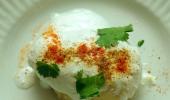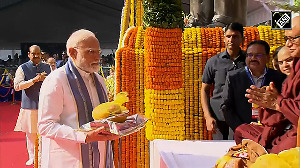
Dahi or yoghurt, when made well, is as delightful as eating ice cream.
It's so refreshing and satiating. Plus far healthier than ice cream to boot.
Lucky for us yoghurt is an essential part of daily eating in India. If it is had along with a serving or two of dal, lightly-cooked vegetables and a few rotis, you have a perfectly healthy, well-balanced Indian meal. And if the dahi is made into a raita, all the better.

First a word on yoghurt. Making dahi is an art. It seems easy, but does not always work out well if the climate is against you.
Remember the care our grandmothers would take while making their bowls of yoghurt -- the milk was warmed to exactly the right temperature and filled into those red earthenware matkas/containers and placed to set in those mesh cupboards (dolis), to protect it from the ants. How creamy and wholesome it would turn out.
It is important to try and make dahi at home, well because it tastes better than the store merchandise and is the healthier way to do it. There can be challenges.
If the weather is too hot, it can set quicker than you can keep track of and become noisily khatta, literally singing in its tapeela (bowl).
More difficult is making dahi in colder climes.
I always carry my little joran or starter sample of yoghurt with me on the long flight when I visit my daughter in Dublin, because who can live without dahi for even a day? (Don't do this on flights to the US because at customs the tame-looking sniffer dogs will metamorphose into bloodhounds and come after you.)
But it's a fight to create dahi in Dublin, with its chilly weather and kabhi-ha-kabhi-na sunshine. Sometimes I have set it across two or three days, heating up the oven to place it in, but with rather disappointing results.
Once, I thought maybe the joran had given up on me and located a preservative-free sheep's milk yoghurt from an organic food store and mixed that in too and finally found success.
But I then found an easier method, courtesy a Christmas present from the family, who felt they needed to put an end to my fretting over my dahi -- a yoghurt maker.
I have a simple Indian-made machine that does the job more than adequately, whatever the weather, although it has no automatic turn off button and such like. It is not the granny's way of doing it, but it sure is convenient.
Now let me sell you the merits of yoghurt. Each serving, according to WebMD contains plenty of protein, vitamin A, vitamin C, vitamin D, calcium, potassium and phosphorus. A 100-gm container of it has 3 gm fat, and if you opt for low-fat milk that reduces further.
Dahi has probiotic bacteria that improves gut health and helps with both diarrhea and constipation, as well as preventing heart disease, rheumatoid arthritis, osteoporosis and cancer, so consider having the recommended three servings a day and ensure it is a staple in your diet.

On to raitas: Daily salads, multiple times, should be the backbone of one's nutrition. Combining salad and yoghurt to prepare, voila, a raita is a highly tasty and versatile option.
The trick is to let you imagination run free. Nearly any vegetable can be made into a raita, whether it is fried, semi-fried, cooked, steamed, raw (the rawer the better and chopped into tiny pieces) and elevated with a little tadka. To that you can add legumes, bundi and more.
Convert chaats into raita and incorporate fruit too. Arils of pomegranate are an ideal choice. Even segments of oranges and pomellos.

Fruit raitas are also great stuff, that can be made tastier than commercial fruit yoghurts with chatpata ingredients or jaggery.
Raitas are not just for everyday fare. They make a special addition to a fancy dinner/lunch being served to guests. They are so easy to put together and the flavour they add to a meal is exponential.
Try this chaat-like Alu, Sprouts Pomegranate Raita, which is a good side dish to any repast.
While the Paneer-Capsicum Raita, I have offered, is suitable for entertaining.

Alu, Sprouts, Pomegranate Raita
Serves: 2-3
Ingredients
- 1 large alu or potato, boiled, chopped into 1-cm pieces
- 3 tbsp arils or seedpods anar or pomegranate
- 1 handful green mung sprouts
- 200 ml dahi or yoghurt, chilled
- Pinch chaat masala
- Pinch red chilly powder, optional
- Pinch salt
- 1 tbsp chopped green dhania or coriander.
Method
- In a medium serving bowl, whip the dahi using a whisk so it has an even consistency.
Mix in the salt, chaat masala, red chilly powder.
Add in the sprouts, pomegranate and the potato pieces (you can choose to keep the peels on or peel; peels on boiled potatoes add nutrients and taste) and mix.
Garnish with dhania and chill till ready to serve

Paneer-Capsicum Raita
Serves: 2-3
Ingredients
- 100 gm paneer, chopped into tiny ½-cm pieces
- ½ cup chopped green Shimla mirch or green capsicum/bell pepper
- 5 to 8 sambar onions, chopped in half
- 1 tbsp oil for frying the paneer
- 1 tsp mustard oil
- ½ tsp kalonji or nigella seeds
- ½ tsp rai or mustard seeds
- Pinch salt
- Pinch hing or asafoetida
- Pinch chaat masala
- Pinch red chilly powder, optional
- Pinch ground rai or mustard powder
Method
- Fry the tiny pieces of paneer, in a frying pan, in the 1 tbsp oil, till pinkish on all sides, over low heat.
Drain and pat dry with a paper towel to remove as much excess oil as possible.
Keep aside. - Then fry the sambar onion halves for about 4-5 minutes only in the same pan, over medium heat.
Drain and pat dry with a paper towel to remove as much excess oil as possible.
Keep aside. - In a medium serving bowl, whip the dahi using a whisk so it has an even consistency.
Mix in the salt, chaat masala, red chilly powder, ground mustard powder.
Keep aside. - Heat the 1 tsp mustard oil, over medium heat, in a tempering pan and add the kalonji seeds, rai seeds, hing.
Allow it to crackle for a minute and pour the tadka into the whipped, seasoned yoghurt.
Add in the capsicum and sambar onions and mix. - Chill till ready to serve and add in the pieces of paneer just before serving.
WATCH: How to make dahi at home
Lead Image: Kind courtesy @TheAaryanKartik/X












 © 2025
© 2025